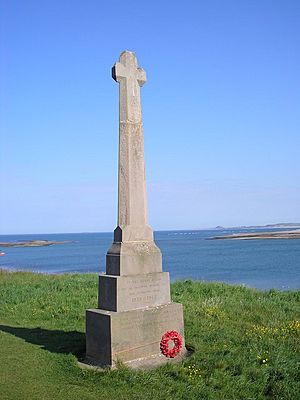Holy Island War Memorial facts for kids
Quick facts for kids Holy Island War Memorial |
|
|---|---|
| United Kingdom | |
 |
|
| For men from Lindisfarne killed in the First World War | |
| Unveiled | 1922 |
| Location | 55°40′06″N 1°48′02″W / 55.66827°N 1.80065°W The Heugh, Lindisfarne, Northumberland
|
| Designed by | Sir Edwin Lutyens |
|
Listed Building – Grade II
|
|
| Official name | Lindisfarne War Memorial |
| Designated | 15 May 1986 |
| Reference no. | 1042308 |
The Holy Island War Memorial, also known as the Lindisfarne War Memorial, is a special monument. It remembers the brave people from Lindisfarne (or Holy Island) who died in the First World War. Lindisfarne is a tidal island found off the coast of Northumberland, in the northeast of England. A famous architect named Sir Edwin Lutyens designed this memorial. It is considered a very important historical site, known as a grade II* listed building.
Contents
Why War Memorials Were Built
After the terrible First World War ended, many thousands of war memorials were built all over Britain. These monuments helped people remember those who had lost their lives. One of the most important designers of these memorials was an architect named Sir Edwin Lutyens. Experts at Historic England called him "the leading English architect of his generation."
Lutyens designed some very famous memorials, like the Cenotaph in London. This monument became the main place for national Remembrance Sunday events. He also designed the Thiepval Memorial to the Missing, which is the biggest British war memorial in the world. Lutyens also created the Stone of Remembrance, which you can see in many large cemeteries run by the Commonwealth War Graves Commission. The Lindisfarne memorial is one of fifteen "War Crosses" designed by Lutyens. They all look quite similar.
Lutyens's Connection to Lindisfarne
Lutyens became well-known for designing large country houses for rich clients. His link to Lindisfarne started in 1902. He was asked to change the 16th-century Lindisfarne Castle into a home. This was for Edward Hudson, who owned Country Life magazine. Hudson owned several properties where he hired Lutyens. This connection likely led to Lutyens being asked to design the Holy Island War Memorial. He even offered his services for free (this is called pro bono).
The Memorial's Design and History
The Holy Island War Memorial is one of Lutyens's "War Cross" designs. It is made from pink stone called ashlar, which came from nearby Doddington. This is the same type of stone used for Lindisfarne Priory. A builder named Mr. Tolly from Belford, Northumberland did the construction work.
What the Memorial Looks Like
The cross has a tall, tapered (meaning it gets narrower towards the top) shaft. It is about 5 meters (16 feet) tall. Near the top, it has short arms that connect to the shaft with a special curved shape called cyma moulding. The shaft stands on three square stones, which sit on a single round step.
Inscriptions and Names
The middle stone has an important message carved into it. On the east side, it says: "TO THE GLORY OF GOD / AND IN GRATEFUL MEMORY OF / OUR GLORIOUS DEAD / 1914 – 1918". This remembers those who died in the First World War. Later, another message was added for the Second World War: "TO THE GLORY OF GOD / AND IN GRATEFUL MEMORY OF / OUR GLORIOUS DEAD / 1939 – 1945". Below these messages, on the lower stones, are the names of the people from Lindisfarne who died in the wars.
Unveiling and Location
The memorial was officially revealed on June 4, 1922. Many people attended the ceremony, which included different Christian churches working together (this is called an ecumenical ceremony). Major Morley Crossman DSO unveiled the memorial, and Reverend WB Hall dedicated it.
The memorial stands on a spot called the Heugh. From here, you can see Lutyens's Lindisfarne Castle and its gardens, which he designed with Gertrude Jekyll. It is also next to the old ruins of Lindisfarne Priory.
Damage and Restoration
The memorial was badly damaged during strong winter storms in 1983–84. The top part of the shaft broke in two because of very strong winds. The broken top part was later replaced.
Listed Building Status
The Holy Island War Memorial was first recognized as a grade II listed building on May 15, 1986. A listed building is a special building that is protected because of its historical or architectural importance. In November 2015, as part of the 100-year anniversary of the First World War, Lutyens's war memorials were recognized as a "national collection." This meant all his free-standing memorials in England had their protection status reviewed. The Lindisfarne memorial was then upgraded from grade II to grade II*. This means it is now considered even more important.

